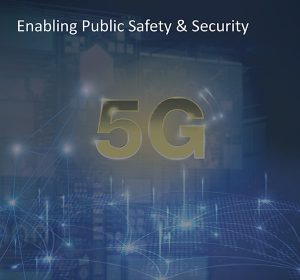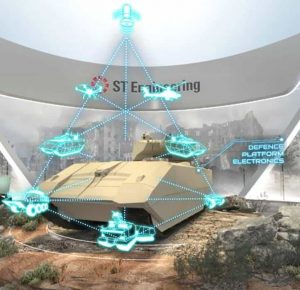Speeding Towards Public Safety and Security with 5G
In an increasingly interconnected world, technology plays a critical role in public safety and security. From emergency response to safeguarding our communities, the ability to access real-time data and communicate speedily can be a matter of life or death.
Traditionally, public safety officers have grappled with the limitations of 4G networks, where latency issues hinder the real-time transmission of high-resolution data, such as video footage. While a typical 4G LTE network can deliver speeds of up to 100 Mbps, 5G, on the other hand, is designed to deliver 1 Gbps or more. This means unprecedented levels of connectivity and responsiveness, promising massive connectivity, allowing it to manage bigger data volumes and bandwidth.
Additionally, 5G has lower latency, significantly reducing a delay in communications. 5G is also more secure than earlier broadband networks, as it has stronger encryption, enhanced authentication and enables segmentation through network slicing.
These capabilities are game-changers for public safety agencies and first responders, enabling them to access critical information and communicate seamlessly in real-time – even in the most challenging environments. Whether it is coordinating emergency responses, analysing surveillance footage, or deploying unmanned systems, 5G empowers responders with the tools they need to act swiftly and decisively.
Empowering rapid response
One of the most significant benefits of 5G for public safety is the ability to support mission-critical communications reliably and efficiently. With 5G-enabled solutions, officers in command can now monitor and survey vast areas from virtual command posts, breaking free from the constraints of traditional deployment methods. In the field, responders can access critical information and resources in real-time.
In crises where existing network infrastructure may be compromised or unavailable, 5G is helpful to quickly deploy a mobile private network to ensure seamless communication and information sharing. This enables responders to remain connected to coordinate efforts effectively and make informed decisions on the ground.
Moreover, 5G’s ability to pull information from various sources and process large volumes of data quickly and efficiently means 5G enables responders to capture and analyse large amounts of high-fidelity information in real-time. This extends from identifying persons of interest, to monitoring crowd behaviour and traffic flow, 5G technology provides invaluable insights that help agencies anticipate and proactively respond to emerging threats.
Furthermore, cutting-edge technologies like network slicing and Multi-access Edge Computing (MEC) enable 5G to empower defense and homeland security operations with unparalleled situational awareness. Real-time, high-volume data, including live video feeds from drones and unmanned ground vehicles, are transmitted in high resolution, enabling swift decision-making and inter-agency collaboration.
Unprecedented situational awareness
ST Engineering is at the forefront of piloting and pioneering new 5G-enabled solutions. ST Engineering’s Visual Intelligence Platform uses a combination of 5G with edge computing capabilities to deploy powerful video analytics. By analysing video feeds from a vast array of sensors, the technology enhances real-time situational awareness in complex urban environments, to identify Persons of Interest, vehicle make, model and even recognises licence plates. ST Engineering’s video analytics can also identify anomalies in behaviour, crowd sizes, crowd flow, and direction of travel.
Another example of ST Engineering’s innovation is the agile 5G-in-a-Box solution which turns forward command vehicles (FCVs), which are mobile command posts used in incidents, into mobile private 5G network stations, enabling seamless connectivity and communication in times of crisis. These FCVs can then operate unmanned assets, such as aerial or ground-based vehicles to gather high-definition video information. This means minimising the need to deploy personnel into potentially dangerous environments while still obtaining critical real-time information for decision-making.
Pioneering Progress
A landmark 5G@Sentosa trial conducted by the Defence Science and Technology Agency (DSTA) and Home Team Science and Technology Agency (HTX) in collaboration with ST Engineering from October 2022 to June 2023, showcases the transformative potential of 5G in safeguarding our communities.
Like a sci-fi movie scene, commanders had donned mixed reality headsets to view a 3D hologram of Sentosa, a resort island off the south coast of Singapore. Coupled with live video feeds from remotely piloted unmanned drone systems, and with clicks and hand motions in a virtual interface, commanders planned a strategy that responders can act on.
This scenario tested the reliability of 5G connectivity for potential defence and homeland security operations that are video-intensive and require minimal transmission lag. The success of the 5G@Sentosa trial not only underscores the viability of 5G-enabled solutions in homeland security but also reaffirms the role of technology as a force multiplier for ground forces worldwide.
A trial highlight was the successful use of network slicing, a 5G-specific capability that involves carving out a portion of the 5G network to create multiple virtual networks for specific applications or services. This ensures that mission-critical applications have dedicated bandwidth without interference from other applications.
Another trial highlight was MEC technology that facilitates the integration of multiple platforms like cameras, edge analytics (such as analysis of data at a sensor) and unmanned systems like drones.
At the same time, ST Engineering engineers worked closely with DSTA and HTX to develop robotic solutions that could improve situational awareness and response and enable inter-agency collaborations where needed.
One of the most striking findings from the testbed was having virtually no lag time in the transmission of live video feeds captured from drones and unmanned ground vehicles. The access to live, high-resolution video and the low latency of 5G enabled officers to make faster, more informed decisions and facilitated seamless collaboration among teams operating in different locations.
Moreover, the testbed demonstrated how 5G technology enables better manpower and resource allocation by empowering officers to monitor and survey areas from a virtual command post.
Another key takeaway from the 5G@Sentosa testbed was the comprehensive coverage afforded by 5G-enabled surveillance systems. Unlike traditional wired cameras, which are limited in their mobility and coverage, 5G allows for the simultaneous transmission of real-time footage from a variety of sources, including wireless static cameras, drones, and body-worn cameras.
Perhaps most impressively, the testbed showcased the resilience of 5G networks in the face of chaos. Network slicing helped to prioritise critical communications and ensure reliable connectivity even in crowded spaces or areas of crisis, 5G networks remained operational and responsive throughout the trial duration. This capability is particularly crucial during times of crisis when network congestion can impede communication and coordination efforts.
The 5G@Sentosa testbed showed how commercially available 5G-enabled solutions can play a definite role in homeland security, and be the force multiplier for ground forces tasked with ensuring the safety and security of communities.











